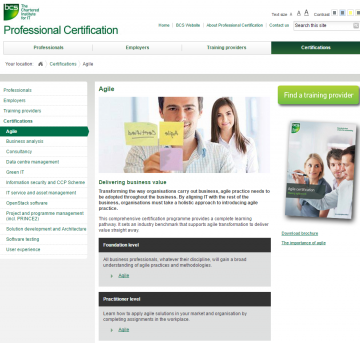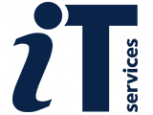Team Resources
In Software Solutions we belive that its important to give our teams a broad understanding of the various agile software development methodologies available.
That is why each of our development team leaders has been certified by the BCS in agile.
BCS The Chartered Institute for IT Agile Qualification Foundation / Practitioner

Scrum and Xp from the Trenches 2nd Edition
This book aims to give you a head start by providing a detailed downtoearth account of how one Swedish company implemented Scrum and Xp with a team of approximately 40 people and how they continuously improved their process over a year's time. Under the leadership of Henrik Kniberg they experimented with different team sizes, different sprint lengths, different ways of defining "done", different formats for product backlogs and sprint backlogs, different testing strategies, different ways of doing demos, different ways of synchronizing multiple Scrum teams, etc. They also experimented with Xp practices different ways of doing continuous build, pair programming, test driven development, etc, and how to combine this with Scrum. This second edition is an annotated version, a "director's cut" where Henrik reflects upon the content and shares new insights gained since the first version of the book.
Agile Product Management: User Stories
Thank you and congratulations on taking this class, “User Stories: How to capture, and manage requirements for Agile Product Management and Business Analysis with Scrum”. In this class, you will be given proven methods to create, maintain and manage your requirements using user stories as part of an agile scrum team. I know you will get value from this class as it gives you a full introduction to the concept of agile user stories for managing product requirements. I then walk you step by step through everything involved in managing requirements using user stories including writing, combining and splitting complex user stories. Following this, I give you a complete overview of epics and themes and how they can be used to capture and group complex requirements in any team or business. Along the way, I give you plenty of examples and give you best practices for working with user stories within agile scrum. In this class, you will learn:
- What User Stories are and why they are so powerful for capturing requirements in complex projects
- Feel confident in writing user stories for any project • Understand what a Requirements Spec is and Why they are less flexible than a Product Backlog built with Agile User Stories
- Explain what The Three Rs rule, Acceptance Criteria, the INVEST Principle, the Three Cs principle and Edge Cases are and how they will make you a better user story writer or agile practitioner
- Understand how and when to split and amalgamate stories
- Learn techniques to help you to split user stories when working in the real world
The Agile Business Analyst
Written with special attention to the challenges facing the IT business analyst, The Agile Business Analyst is a fresh, comprehensive introduction to the concepts and practices of Agile software development. It is also an invaluable reference for anyone in the organization who interacts with, influences, or is affected by the Agile development team.
Business analysts will learn the key Agile principles plus valuable tools and techniques for the transition to Agile, including:
- Card writing
- Story decomposition
- How to manage cards in an Agile workflow
- How to successfully respond to challenges about the value of the BA practice (with an “elevator pitch” for quick reference)
Scrum masters, iteration managers, product owners, and developers who have been suddenly thrust into a work environment with a BA will find answers to the many questions they’re facing:
- What does a BA actually do?
- What’s their role on the team?
- What should I expect from a BA?
- How and when should I involve a BA, and what are the limits of their responsibility?
- How can they help my team increase velocity and/or quality?
People managers and supervisors will discover:
- How the BA fits into the Agile team and SDLC
- Crucial skills and abilities a BA will need to be successful in Agile
- How to get the team and the new BA off on the right foot
- How to explain the BA’s value proposition to others
- How adding a BA can solve problems in an established team
Executives and directors will find answers to critical questions:
- In an Agile world, are BAs a benefit or just a cost to my organization?
- How do I get value from a BA in the transition to Agile?
- Can I get more from my development team by using the BA as a “force multiplier”?
- What expectations should I be setting for my discipline managers?
Agile Project Management
Agile Project Management in easy steps, now in its second edition, explains the key principles, techniques, and processes to ensure your agile project is a success. This edition of the book has been updated to reflect progress and refinement of agile methods over recent times. It explains the key principles, techniques and processes of agile project management, working through an entire project, explaining the main activities and deliverables including:
- Pre-project start-up and terms of reference
- Feasibility assessment and the business case
- Establishing the foundations for success
- Iterative development and the evolving solution
- Implementation and post-project assessment
It includes additional coverage of business analysis, user experience, feature-driven development and agile projects in large programmes and enterprises. An essential guide for anyone new to agile projects and a valuable source of inspiration for the more experienced. It also includes downloadable templates to get you started.
More Agile Testing
Janet Gregory and Lisa Crispin pioneered the agile testing discipline with their previous work, Agile Testing. Now, in More Agile Testing, they reflect on all they’ve learned since. They address crucial emerging issues, share evolved agile practices, and cover key issues agile testers have asked to learn more about.
Packed with new examples from real teams, this insightful guide offers detailed information about adapting agile testing for your environment; learning from experience and continually improving your test processes; scaling agile testing across teams; and overcoming the pitfalls of automated testing. You’ll find brand-new coverage of agile testing for the enterprise, distributed teams, mobile/embedded systems, regulated environments, data warehouse/BI systems, and DevOps practices.
You’ll come away understanding
• How to clarify testing activities within the team
• Ways to collaborate with business experts to identify valuable features and deliver the right capabilities
• How to design automated tests for superior reliability and easier maintenance
• How agile team members can improve and expand their testing skills
• How to plan “just enough,” balancing small increments with larger feature sets and the entire system
• How to use testing to identify and mitigate risks associated with your current agile processes and to prevent defects
• How to address challenges within your product or organizational context
• How to perform exploratory testing using “personas” and “tours”
• Exploratory testing approaches that engage the whole team, using test charters with session- and thread-based techniques
• How to bring new agile testers up to speed quickly–without overwhelming them

InfoQ



